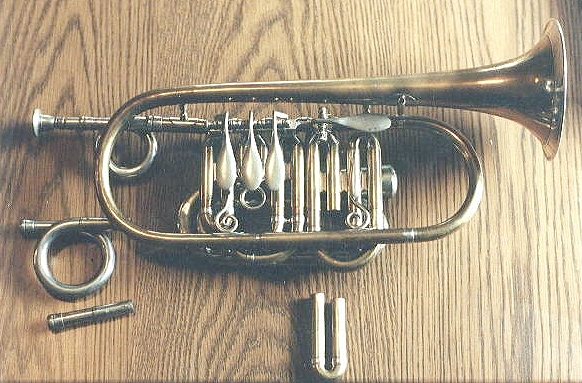Echo Cornet by D.C. Hall
This is another fabulous and important instrument from Steve Ward's collection. I performed a few minor repairs on it, but it doesn't qualify for my "restoration" pages, because it is an amazing example of preservation, including the original walnut case. The only part that I made for it was the mouthpipe shank. I don't know what else was missing from the rectangular slot in the case, perhaps a grease tin. It is pitched in C with the mouthpipe shank in place and the crooks lower the pitch to Bb, A and G.
Click on image for larger views.
When the echo is detached and the slide is inserted, the fourth valve lowers the pitch five semitones; the C cornet is lowered to G and the Bb cornet is lowered to F. This cornet has the same bore and bell profile as the "Orchestra Cornet" that is also featured on this site. The two were made at about the same time (1862-1865) and I was able to reproduce the missing crooks from these originals.
Hall made somewhat of a specialty of making echo instruments for a short time, although examples are extremely rare. Most known examples are in the Henry Ford Museum and include seven instruments that are what's left of a set of instruments that were made for the Boston Brass Band in about 1862, all made of copper with nickel silver trim. They were made in all sizes from Eb cornet to Eb bass and include a valve trombone and circular alto in F (like later mellophones).
The last photo above was provided by Bob Eliason that he took at the Converse Free Library, Lyme, NH. This cornet is the same design as Steve Ward's except that the bell and other primary tubing is made of brass with the balance of nickel silver and was made a few years later by Hall & Quinby for D.C. Hall's brother Rhodolph. This would have been a replacement or spare instrument to replace an almost identical cornet made for him in 1861. That original was described as being made of solid gold. These two brothers were both important musicians in the New England music scene and performances by Rhodolph on the "Magic Echo" cornet were widely publicized and reported on in the newspapers. Indeed, it was almost certainly the notoriety of these performances that led to the Boston Brass Band acquiring the set.
The idea of the echo attachment on a cornet was quite novel at the time and these instruments seem to be specifically designed to hide the attachment from the audience. Most of this historical information comes from articles published by Bob Eliason. I recommend reading his articles on David and Rhodolph Hall that were published in 2003 and 2007 in the American Musical Instrument Society Journal.
The makers Allen, Hall and the Quinby Brothers made numerous variations of this popular cornet design (mostly without echo). Two more are shown below. The first in Dan Rossi’s collection, made of copper and silver is pitched in Bb with fourth valve that raises the pitch to C. The next, in Mark Elrod’s collection, made of copper and nickel silver. This circular cornet is pitched in Bb with fourth valve that lowers the pitch by 5 semitones.






